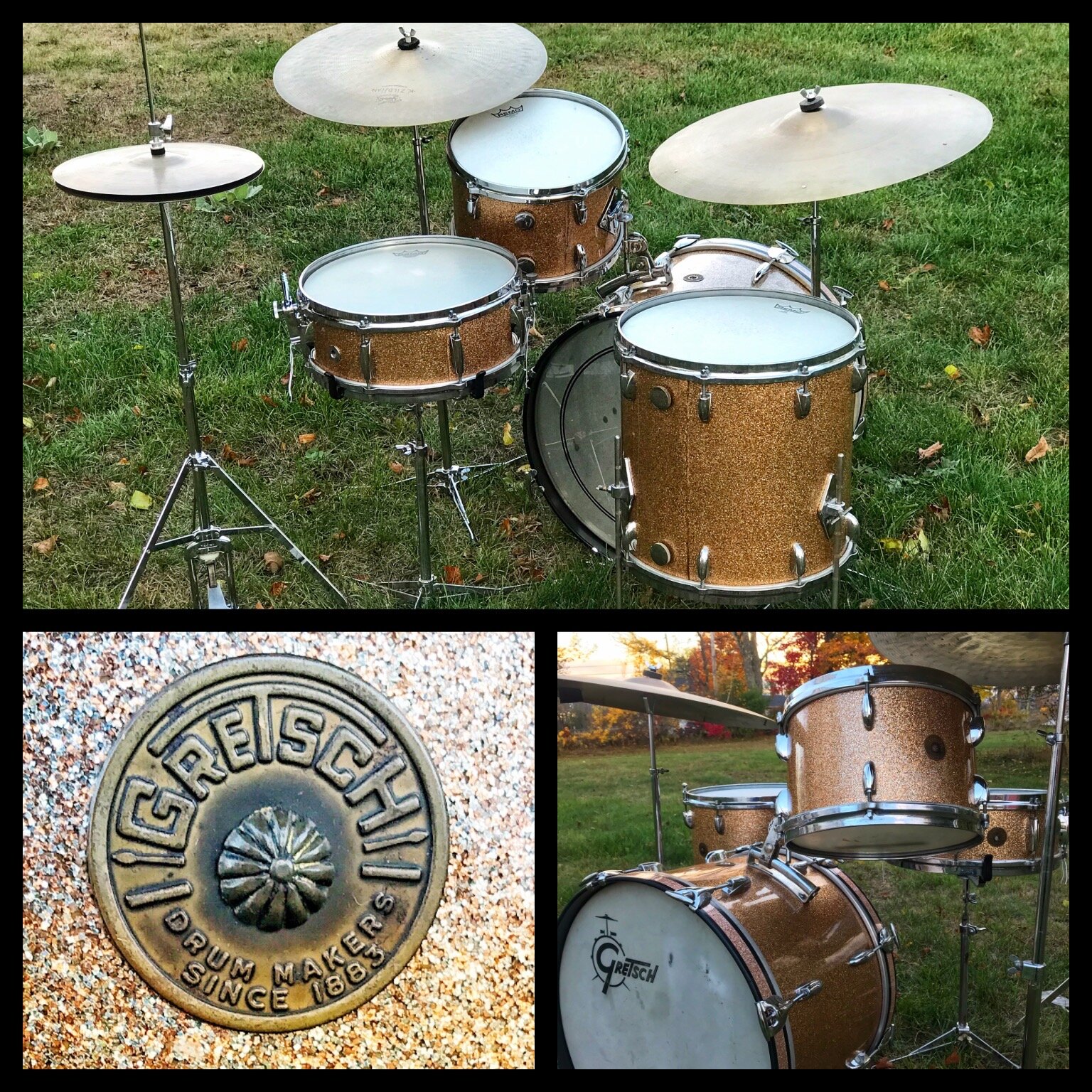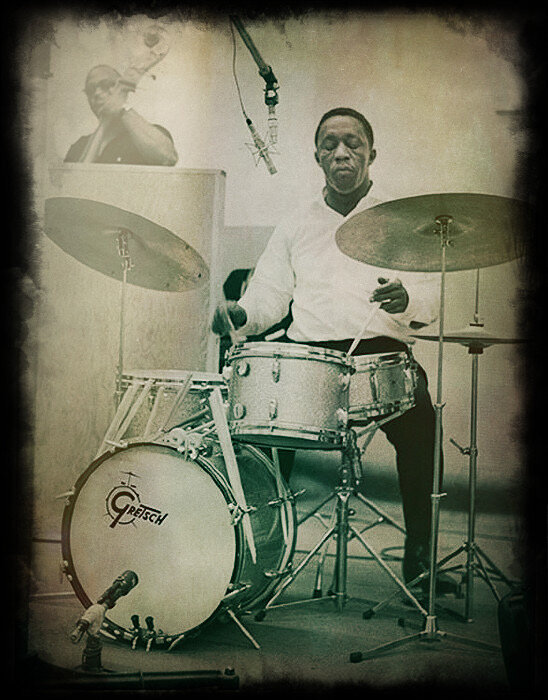Gretsch…. It is a name synonymous with famous jazz drummers through the 50s and 60s. It’s a sound that can be heard on many of the great jazz albums of all time along with the distinctive sound of Istanbul K Zildjian cymbals from Turkey. I had mentioned in a previous article that my first set of drums, which I still own, is a Gretsch from the mid 70s. I was obviously familiar with Gretsch drums when I joined my high school jazz band in my junior year of high school in the fall of 1988. My Gretsch set however is not a jazz sized set and back in the 80s I had pinstripe heads on all the toms, a 6.5x14 chrome Supraphonic 402 tuned for rock along with heavy weight crash cymbals and a ping ride. My hardware was also the big heavy kind that could double as a crane at a construction site. Did it work? It had to as I had no other option and not only that, I knew even less about what drums and cymbals jazz drummers used and how they tuned them. Drums were just drums right? Or so I thought at 17 years of age. I learned several things that year being in that band. One of my best friends Bill was already miles ahead of everyone else playing jazz piano and being around him made me realize how specialized this style of music is. I also quickly learned that I don’t care for having two toms up top and I took away the 13 and moved the ride in closer. To this day I almost always use one tom. I also befriended an older gentleman named Stan that already knew Bill and he knew more about jazz then anyone I have ever met. He didn’t play any instruments but had seen all the greats from years past and had a deep love of jazz music and cars. Stan was the guy who took me to see a lot of great jazz guys before they passed and we saw many a show up until he passed several years ago.
After I graduated high school, I got the vintage bug. Specifically the Ludwig bug as I had lusted after Ludwig drums for years. All of my favorite players played Ludwig and soon I was on my way to collecting the drums of my dreams. One thing I could not fully understand though were fanatical collectors that had a thing for round badge Gretsch drums. I thought they looked cool but most if not all the Gretsch drums I encountered were either in terrible shape, had problems with heads fitting, wrap issues or were just crazy expensive. I had a similar feeling about K Zildjian cymbals. I just never really got what the fuss over them was as they just looked like beat up old Zildjian cymbals to me that were pretty common. I had heard all the stories of “That Great Gretsch Sound” but I guess I just figured that most of that was just hype of some sort. The change for me occurred when I had a chance to check out the Los Angeles Vintage drum show as I was out that way in late 1998.
The Hollywood drum show was held in Inglewood California and it felt good to walk around and see the many booths and look at all the cool vintage Ludwig drums. Out of nowhere I heard the sound of jazz coming from the center of the room. It was a sound I had heard before but I was drawn to where this sound was coming from. I had heard many people play jazz on vintage drums but this sound seemed to be THE sound that I had heard on old jazz records. As I came upon this set of drums centered in what seemed like the middle of the room, the drummer playing them got up and walked away. What sat before me was a vintage round badge Gretsch in sizes 8x12, 14x14, 14x18 with a chrome round badge 5x14 snare drum. The drums looked pretty beat up as they were finished in a walnut finish with a multitude of scratches and dings from the years gone by. The heads looked like tires on a car that had gone millions of miles and the cymbals, old K’s were cracked and played to death. I circled the set a few times wondering how the sound I heard had come from this beat up little set? I was hoping that some other drummer would come by and play these when someone at the booth must have noticed me and motioned for me to “have a go” on the set. I quickly declined as I am not usually a fan of making added noise at a drum show but this guy persisted. Curiosity got the best of me and I decided that having a few taps at it couldn’t hurt. Right away I was shocked at the sound coming out of these tiny drums! They were tuned up high for bop jazz and the drums just had that instantly recognizable 50’s 60’s sound I had heard on all those old jazz records. The cymbals had this great definition with a nice wash that quickly got out of the way when crashed just right and the Hi Hats had a nice mellow tone that was not to sharp or piercing to the ears. The snare also had a great snap to it and the head was very beat up and blackened from the years of someone playing brushes on it. I couldn’t help myself as I had to have a little buzz around them. For a moment the sound of Art Blakey and Elvin jones came from the drums even if all that technique may not have been there. At least that is the sound I heard but more than any of that, I finally understood the whole Gretsch/K Zildjian thing. Sure any good drummer should be able to make a bad set of drums sound good but this was sonic tones that I was being made aware of. I will never forget that drum set as it left a very lasting impression on me.
I had kind of put the whole Gretsch thing out of my head as finding round badge sets in good condition with no mods at a manageable price has always been pretty tricky. I stayed tried and true with my Ludwig quest and at one point I even owned a nice 70’s jazzette for a few years. I loved that set however it was not being used much as the opportunity to play jazz in my area is slim to none. I decided to sell them and focus on my other drums and gigs that I was doing. Jazz never left me though and neither did the sound of that Gretsch set. Fast forward to June of 2020. A friend of mine had come across a set of mismatched champagne sparkle drums that included a Gretsch round badge 5x14 name band snare drum, 8x12 tom and 14x14 floor tom. Visions of that 1998 drum show Gretsch set pooped into my head and I purchased the three Gretsch drums. While having an 18” bass drum would be great, I also realize how incredibly rare they are and instead focused my search for a 20” bass drum so I could have a complete Gretsch progressive jazz set. The other three drums were cleaned up and worked on while I put feelers out for a bass drum. I ended up needing a diamond mount for the 8x12 as a Ludwig mount had been added at some point. Fortunately any extra holes were covered with the Gretsch mount. I also needed a muffler and I decided to order a reproduction micro-sensitive strainer for the snare drum as the original one wasn’t working all that well. After all three of the drums were polished up, seams glued back down and new parts added, I got a message on Facebook messenger that a matching bass drum was for sale not too far from me. Talk about good timing! The puzzle is finally complete and it looks as though all of the drums originally came together.
I’m not sure any Gretsch set will sound quite the way the set back in 1998 sounded. Maybe it was my imagination, maybe it was the big open room or maybe it was just the experience of hearing a set like that in person for the first time. Whatever the case, those drums really opened my eyes and I am finally glad to have the opportunity to own a vintage round badge Gretsch for myself. I also managed to trade a few things for a really nice set of Istanbul K Zildjian hi Hats. The combination of the drums, the Hi Hats and my other Zildjian cymbals really make this set a lot of fun to play. Maybe one day jazz will become more popular again and there will be more opportunities to use these with a band. Until then I get to work on my jazz licks and appreciate Art Blakey records even more than I already do.




